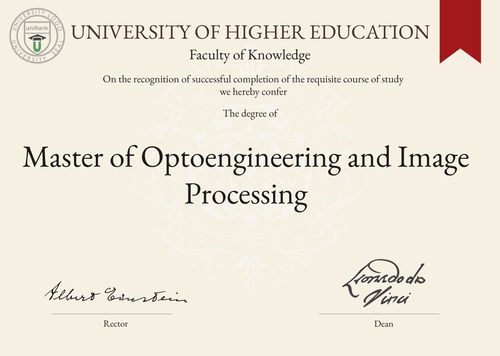
Master of Optoengineering and Image Processing (M.OptEng)
Guide to Master of Optoengineering and Image Processing Program/Course/Degree
Master of Optoengineering and Image Processing (M.OptEng)

Program Name:
Master of Optoengineering and Image ProcessingProgram or Degree abbreviation:
M.OptEngDuration range:
Varies by country and university (typically 1-2 years)Tuition range:
Varies by country and university (typically $10,000-$30,000 per year)Overview:
The Master of Optoengineering and Image Processing program is designed to provide students with advanced knowledge and skills in the field of optoengineering and image processing. This program combines theoretical and practical training to equip students with the necessary expertise to work in various industries such as telecommunications, medical imaging, robotics and more.Curriculum Overview by year:
- Year 1: - Introduction to Optoengineering - Image Processing Techniques - Optical Instrumentation - Digital Signal Processing - Electromagnetic Waves and Optics - Year 2: - Advanced Optoengineering - Image and Video Compression - Machine Learning for Image Processing - Optoelectronic Devices - Research ProjectKey Components:
- Understanding of optical systems and their applications - Proficiency in image processing techniques and algorithms - Knowledge of optoelectronic devices and their integration - Ability to analyze and interpret optical data - Hands-on experience with optical instrumentation and software toolsCareer Prospects:
Graduates of the Master of Optoengineering and Image Processing program can pursue various career paths, including: - Optoengineering Researcher - Image Processing Engineer - Optical Systems Designer - Telecommunications Engineer - Medical Imaging Specialist - Robotics EngineerSalary Expectations:
Salaries for professionals in the field of optoengineering and image processing can vary depending on factors such as experience, location and industry. On average, graduates can expect a starting salary ranging from $60,000 to $80,000 per year, with potential for higher earnings as they gain more experience. For a more accurate understanding of salary expectations, you can utilize the Job Sites Search Engine, from our sister site jobRank, which searches over 4,600 job sites worldwide. Make sure to specify not only the job title but also the country you are interested in.Conclusions:
It is important to note that the duration, tuition fees, curriculum, key components, career prospects and salary expectations of the Master of Optoengineering and Image Processing program can vary depending on the chosen country or location of study, as well as the chosen university. Prospective students are advised to research and compare different programs and universities to find the best fit for their goals and circumstances. Visitors interested in pursuing a Master of Optoengineering and Image Processing degree can use the uniRank World Universities Search Engine to search for universities offering this specific degree anywhere in the world. This tool provides a comprehensive database of universities and their programs, allowing individuals to find the most suitable options for their educational journey.World Universities Search Engine
search for Master of Optoengineering and Image Processing (M.OptEng) and add the Location (country, state etc.) or specific University you are interested in studying at.
Query examples:
- Master of Optoengineering and Image Processing (M.OptEng) United States
- Master of Optoengineering and Image Processing (M.OptEng) United Kingdom online
- Master of Optoengineering and Image Processing (M.OptEng) Australia international students
- Master of Optoengineering and Image Processing (M.OptEng) University of California
- Master of Optoengineering and Image Processing (M.OptEng) University of London tuition fees
- Master of Optoengineering and Image Processing (M.OptEng) University of Sydney scholarships
Share Program/Course
Interesting? Share this program/course/degree info with your friends now.